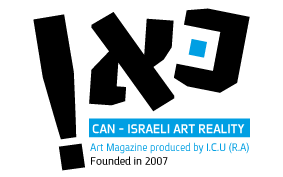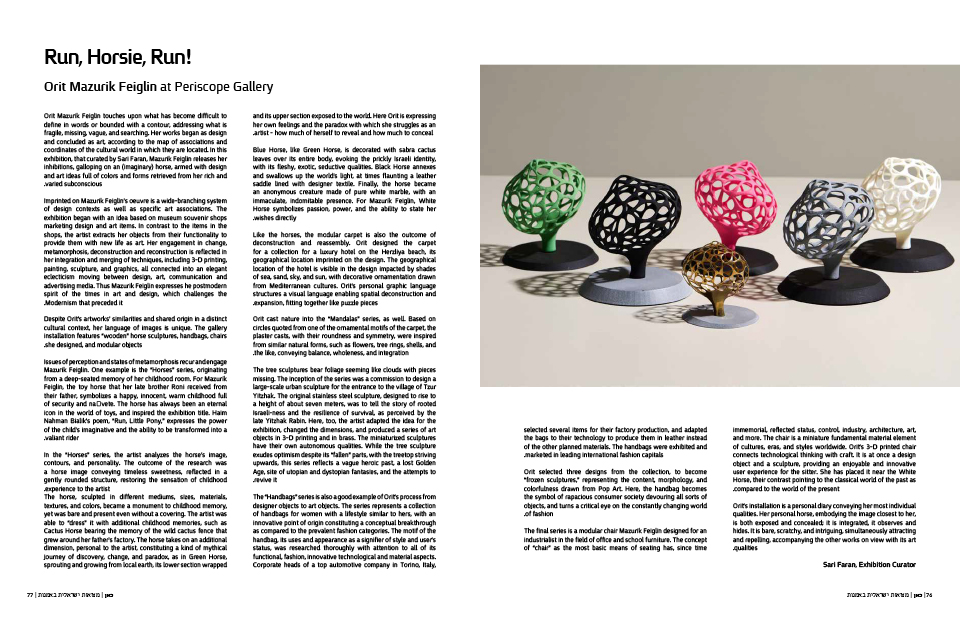
| Home Page | Editor Notices | Museums | Galleries | Publication | Donation | Contact Us |


 | |||||||||||||||
| |||||||||||||||


| |||||||||||||||
| Orit Mazurik Feiglin at Periscope Gallery |
Orit Mazurik Feiglin touches upon what has become difficult to define in words or bounded with a contour, addressing what is fragile, missing, vague, and searching. Her works began as design and concluded as art, according to the map of associations and coordinates of the cultural world in which they are located. In this exhibition, that curated by Sari Faran, Mazurik Feiglin releases her inhibitions, galloping on an (imaginary) horse, armed with design and art ideas full of colors and forms retrieved from her rich and varied subconscious. Imprinted on Mazurik Feiglin’s oeuvre is a wide-branching system of design contexts as well as specific art associations. The exhibition began with an idea based on museum souvenir shops marketing design and art items. In contrast to the items in the shops, the artist extracts her objects from their functionality to provide them with new life as art. Her engagement in change, metamorphosis, deconstruction and reconstruction is reflected in her integration and merging of techniques, including 3-D printing, painting, sculpture, and graphics, all connected into an elegant eclecticism moving between design, art, communication and advertising media. Thus Mazurik Feiglin expresses he postmodern spirit of the times in art and design, which challenges the Modernism that preceded it. Despite Orit’s artworks’ similarities and shared origin in a distinct cultural context, her language of images is unique. The gallery installation features “wooden” horse sculptures, handbags, chairs she designed, and modular objects. Issues of perception and states of metamorphosis recur and engage Mazurik Feiglin. One example is the “Horses” series, originating from a deep-seated memory of her childhood room. For Mazurik Feiglin, the toy horse that her late brother Roni received from their father, symbolizes a happy, innocent, warm childhood full of security and na?vete. The horse has always been an eternal icon in the world of toys, and inspired the exhibition title. Haim Nahman Bialik’s poem, “Run, Little Pony,” expresses the power of the child’s imaginative and the ability to be transformed into a valiant rider. In the “Horses” series, the artist analyzes the horse’s image, contours, and personality. The outcome of the research was a horse image conveying timeless sweetness, reflected in a gently rounded structure, restoring the sensation of childhood experience to the artist. The horse, sculpted in different mediums, sizes, materials, textures, and colors, became a monument to childhood memory, yet was bare and present even without a covering. The artist was able to “dress” it with additional childhood memories, such as Cactus Horse bearing the memory of the wild cactus fence that grew around her father’s factory. The horse takes on an additional dimension, personal to the artist, constituting a kind of mythical journey of discovery, change, and paradox, as in Green Horse, sprouting and growing from local earth, its lower section wrapped and its upper section exposed to the world. Here Orit is expressing her own feelings and the paradox with which she struggles as an artist – how much of herself to reveal and how much to conceal. Blue Horse, like Green Horse, is decorated with sabra cactus leaves over its entire body, evoking the prickly Israeli identity, with its fleshy, exotic, seductive qualities. Black Horse annexes and swallows up the world’s light, at times flaunting a leather saddle lined with designer textile. Finally, the horse became an anonymous creature made of pure white marble, with an immaculate, indomitable presence. For Mazurik Feiglin, White Horse symbolizes passion, power, and the ability to state her wishes directly. Like the horses, the modular carpet is also the outcome of deconstruction and reassembly. Orit designed the carpet for a collection for a luxury hotel on the Herzliya beach, its geographical location imprinted on the design. The geographical location of the hotel is visible in the design impacted by shades of sea, sand, sky, and sun, with decorative ornamentation drawn from Mediterranean cultures. Orit’s personal graphic language structures a visual language enabling spatial deconstruction and expansion, fitting together like puzzle pieces. Orit cast nature into the “Mandalas” series, as well. Based on circles quoted from one of the ornamental motifs of the carpet, the plaster casts, with their roundness and symmetry, were inspired from similar natural forms, such as flowers, tree rings, shells, and the like, conveying balance, wholeness, and integration. The tree sculptures bear foliage seeming like clouds with pieces missing. The inception of the series was a commission to design a large-scale urban sculpture for the entrance to the village of Tzur Yitzhak. The original stainless steel sculpture, designed to rise to a height of about seven meters, was to tell the story of rooted Israeli-ness and the resilience of survival, as perceived by the late Yitzhak Rabin. Here, too, the artist adapted the idea for the exhibition, changed the dimensions, and produced a series of art objects in 3-D printing and in brass. The miniaturized sculptures have their own autonomous qualities. While the tree sculpture exudes optimism despite its “fallen” parts, with the treetop striving upwards, this series reflects a vague heroic past, a lost Golden Age, site of utopian and dystopian fantasies, and the attempts to revive it. The “Handbags” series is also a good example of Orit’s process from designer objects to art objects. The series represents a collection of handbags for women with a lifestyle similar to hers, with an innovative point of origin constituting a conceptual breakthrough as compared to the prevalent fashion categories. The motif of the handbag, its uses and appearance as a signifier of style and user’s status, was researched thoroughly with attention to all of its functional, fashion, innovative technological and material aspects. Corporate heads of a top automotive company in Torino, Italy, selected several items for their factory production, and adapted the bags to their technology to produce them in leather instead of the other planned materials. The handbags were exhibited and marketed in leading international fashion capitals. Orit selected three designs from the collection, to become “frozen sculptures,” representing the content, morphology, and colorfulness drawn from Pop Art. Here, the handbag becomes the symbol of rapacious consumer society devouring all sorts of objects, and turns a critical eye on the constantly changing world of fashion. The final series is a modular chair Mazurik Feiglin designed for an industrialist in the field of office and school furniture. The concept of “chair” as the most basic means of seating has, since time immemorial, reflected status, control, industry, architecture, art, and more. The chair is a miniature fundamental material element of cultures, eras, and styles worldwide. Orit’s 3-D printed chair connects technological thinking with craft. It is at once a design object and a sculpture, providing an enjoyable and innovative user experience for the sitter. She has placed it near the White Horse, their contrast pointing to the classical world of the past as compared to the world of the present. Orit’s installation is a personal diary conveying her most individual qualities. Her personal horse, embodying the image closest to her, is both exposed and concealed; it is integrated, it observes and hides. It is bare, scratchy, and intriguing, simultaneously attracting and repelling, accompanying the other works on view with its art qualities. Sari Faran, Exhibition Curator Read more  |
| all rights reserved - CAN ISRAELI ART REALITY |
| סייבורג מחשבים - בניית אתרים |